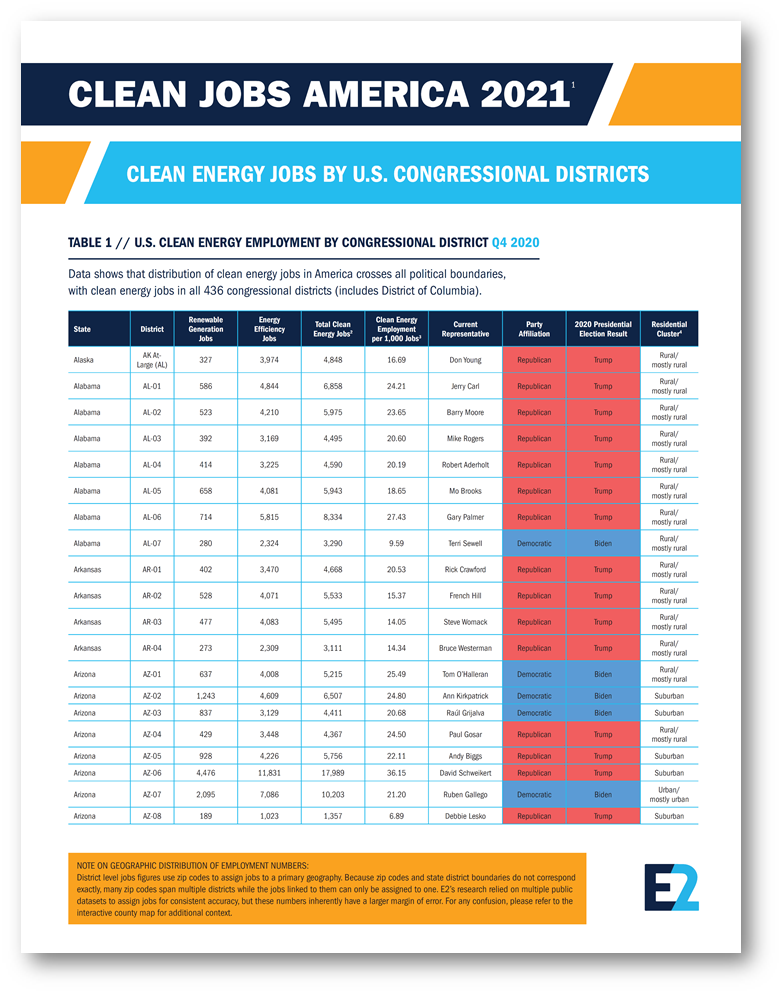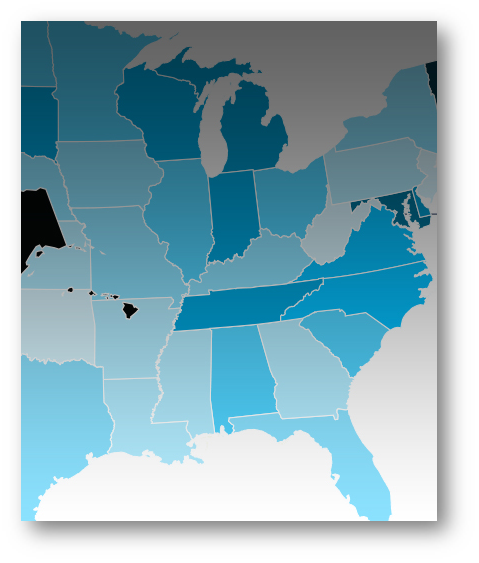

Every Day, 3 Million Americans Across all 435 Congressional Districts Work Building Our Clean Energy Economy.
Clean energy is a critical job creator in every state – employing 1 in every 50 American workers. More Americans today work in clean energy than as lawyers, police officers, farmers, firefighters, kindergarten teachers, and mail carriers combined.
Clean Jobs America 2021 | Clean Energy Jobs By U.S. Congressional Districts is a new searchable database of U.S. employment across clean energy sectors (renewable energy, energy efficiency, clean vehicles, clean fuels, and storage and grid modernization) across all 435 U.S. congressional districts.
KEY FINDINGS
435 Districts Are Home To Clean Energy Jobs
432 Districts Have >1,000 clean energy jobs
388 Districts Have >3,000 clean energy jobs
279 Districts Have >5,000 clean energy jobs
79 Districts Have >10,000 clean energy jobs
Residential Density
Suburban: 39.7% (1,211,306 clean energy job)
Rural or mostly rural: 38.6% (1,175,937 jobs)
Urban or mostly urban: 21.7% (661,360 jobs)
Party Affiliation
Democratic-led Districts: 54.3% (1,655,244 clean energy jobs)
Republican-led Districts: 44.9% (1,368,040 jobs)
Vacant Districts: 0.8% (25,320 jobs)
Top Districts by Total Clean Energy Jobs
| State | Current Rep | Total Clean Energy Jobs |
| Calif. | Ro Khanna (D) | 33,109 |
| Calif. | Nancy Pelosi (D) | 32,414 |
| Texas | Dan Crenshaw (R) | 21,558 |
| Utah | John Curtis (R) | 21,285 |
| Calif. | Katie Porter D) | 19,813 |
| Colo. | Diana DeGette (D) | 18,637 |
| Ariz. | David Schweikert (R) | 17,989 |
| Calif. | Jared Huffman (D) | 17,900 |
| Ill. | Danny K. Davis (D) | 17,643 |
| Calif. | Mark DeSaulnier (D) | 17,275 |
FULL REPORT
Download the complete report and explore the national map at at this link.
ABOUT THE REPORT
The analysis expands on Clean Jobs America 2021 and is based on preliminary employment data collected and analyzed by BW Research Partnership for the 2021 U.S. Energy and Employment Report (USEER) released by the Department of Energy (DOE). The USEER analyzes data from the U.S. Bureau of Labor Statistics (BLS) Quarterly Census of Employment and Wages (QCEW) to track employment across many energy production, transmission, and distribution subsectors. For more information on the methodology click here
Job Density
Clean energy job density calculations for congressional districts used the U.S. Census Bureau 2019 County Business Patterns and the Bureau of Labor Statistics (BLS) 2020 Q4 QCEW employment data, analyzed and extrapolated by BW Research.
Residential Clusters
This report uses the CityLab Congressional Density Index (CDI) by David Montgomery to define congressional district residential clusters. Methodology for the CDI is available here. To condense the definitions into three categpories, this analysis combines:
- “Pure rural” and “Rural-suburban mix” clusters into “Rural/mostly rural”
- “Dense suburban” and “Sparse suburban” clusters into “Suburban”
- “Pure urban” and Urban-suburban mix” clusters into “Urban/mostly urban”
What Jobs We Include
This analysis defines clean energy employment as jobs in solar energy, wind energy, combined heat and power, bioenergy, non-woody biomass, low-impact hydro power, geothermal, clean vehicle technologies, clean energy storage, smart grid, micro grid, grid modernization, advanced biofuels, and energy efficiency including ENERGYSTAR and high efficiency appliances, efficient lighting, HVAC, renewable heating and cooling, and advanced building materials. Jobs in retail trade, repair services, water or waste management, and indirect employment or induced employment are not included.
Note On Geographic Distribution Of Employment Numbers
District level jobs figures use zip codes to assign jobs to a primary geography. Because zip codes and state district boundaries do not correspond exactly, many zip codes span multiple districts while the jobs linked to them can only be assigned to one. Research relied on multiple public datasets to assign jobs for consistent accuracy, but these numbers inherently have a larger margin of error than state and county findings.
